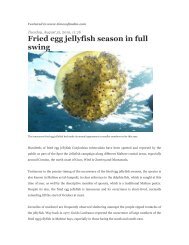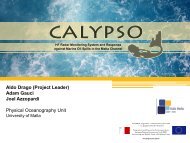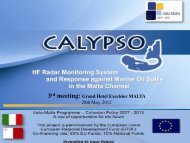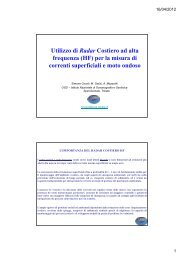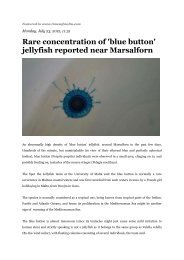Interview with Dr. Alan Deidun - University of Malta
Interview with Dr. Alan Deidun - University of Malta
Interview with Dr. Alan Deidun - University of Malta
You also want an ePaper? Increase the reach of your titles
YUMPU automatically turns print PDFs into web optimized ePapers that Google loves.
Australian Spotted Jellyfish in Italy and the Compass Jellyfish in Spain are two examples. As a<br />
pre-emptive strategy, we place such species on our educational leaflets.” Asked about any<br />
particular chronological patterns in jellyfish blooms, <strong>Dr</strong> <strong>Deidun</strong> explained that from records<br />
dating back 150 years, it is being observed that in recent years peaks have been more frequent<br />
and pronounced. However large masses <strong>of</strong> mauve stingers have been observed for decades and<br />
in the eighties local water polo games had to be cancelled and teams had to go and train<br />
abroad. He recalled that back in the late fifties an advert <strong>of</strong> a jellyfish repellent cream was<br />
published in a local newspaper.<br />
Economical, social and ecological disruption<br />
In the ecological chain, the role <strong>of</strong> jellyfish is to act as scavengers and so serve as a natural<br />
means to eliminate the weakest organisms. Another function is to filtrate water from plankton.<br />
The main problems arise when jellyfish appear in huge numbers all <strong>of</strong> a sudden. The Canary<br />
Islands right now are experiencing a bloom <strong>of</strong> apocalyptic proportions and mauve stingers are<br />
literally being bulldozed from the beaches. In the last 28 days 3.25 tonnes <strong>of</strong> jellyfish were<br />
removed from a single beach. <strong>Dr</strong> <strong>Deidun</strong> cited the positive impact that jellyfish may be having<br />
on the diving industry. He floated the idea that authorities need to seriously consider<br />
promoting a new niche <strong>of</strong> jellyfish tourism, also in view <strong>of</strong> the fact that overfishing is<br />
threatening the already fish depleted seas around <strong>Malta</strong>. Regarding the ecological benefits or<br />
threats that jellyfish pose in general he said that huge outbreaks <strong>of</strong> jellyfish are having a<br />
negative impact on the overall population <strong>of</strong> fish as they are consuming large amounts <strong>of</strong><br />
plankton and other foods on which the fish depend. The traditional kinds <strong>of</strong> jellyfish use their<br />
stingy tentacles full <strong>of</strong> capsules to squirt their venom to catch their prey. Other kinds <strong>of</strong> jellyfish<br />
called comb jellies which are not stingy have sticky tentacles, which have the same purpose.<br />
The latter are becoming more popular <strong>with</strong> divers as these may be handled freely <strong>with</strong>out any<br />
risks. Another form <strong>of</strong> jellyfish that fishermen are familiar <strong>with</strong> are called salps, which<br />
resemble long chains <strong>of</strong> jellyfish which may stretch several kilometres.<br />
“As a marine biologist I am focusing more on the threats especially those caused by stinging<br />
jellyfish and the blooming population which causes an ecological imbalance. In some cases<br />
jellyfish are producing so much mucus, which is a gelatinous substance, that parts <strong>of</strong> the sea<br />
are becoming toxic and consequently impacting negatively on marine life. The best term that



